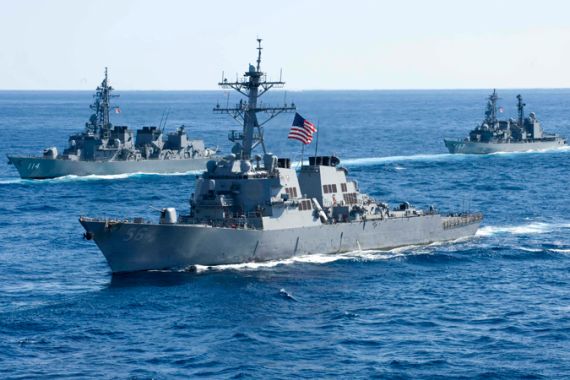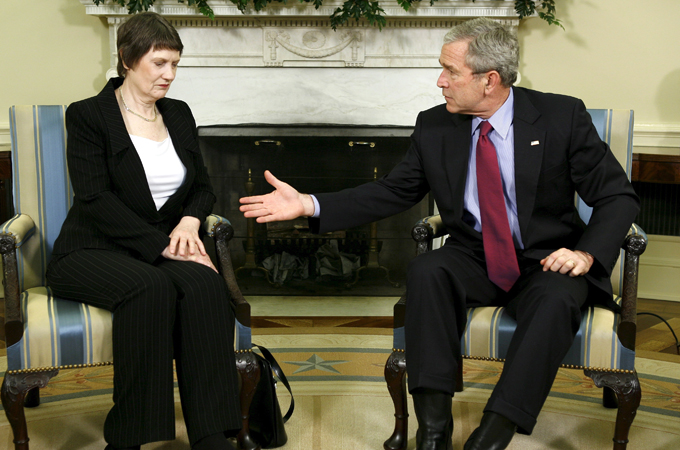WikiLeaks: Power politics at play
New Zealand and US resume controversial intelligence ties after a row over nuclear-armed ships, WikiLeaks cables say.

 |
| Former New Zealand Prime Minister Helen Clark may have been shunning overtures from G W Bush in public, however behind closed doors the realities of global power politics ensured a wholly different response [EPA] |
New Zealand and the United States have secretly re-initiated full intelligence collaboration, 25 years after it was first suspended.
The revelation was first reported by New Zealand’s Sunday Star-Times weekly newspaper, which has obtained 1,490 diplomatic cables from the US embassy in Wellington, courtesy of WikiLeaks.
Keep reading
list of 4 itemsFire engulfs iconic stock exchange building in Denmark’s Copenhagen
Inside the pressures facing Quebec’s billion-dollar maple syrup industry
‘Accepted in both [worlds]’: Indonesia’s Chinese Muslims prepare for Eid
The report is the first in a series of articles by Nicky Hager, a reporter and researcher whose penetrative work regularly jolts New Zealand’s political landscape – fellow antipodean journalist John Pilger has called him “quite simply, one of the world’s leading investigative journalists”.
The revived relationship come decades after United States first shunned military and intelligence ties with the South Pacific nation, as a retaliatory action in protest to New Zealand’s adoption of nuclear-free legislation. US navy ships which were nuclear-powered or nuclear-armed were negatively impacted by the legislation.
The nuclear-free policy has become one of the cornerstones of national identity in New Zealand, and is generally supported across the political spectrum. It embodies what many New Zealanders like to think of as their nation’s rebellious, independent streak.
While the nuclear-free zone remains intact, despite ongoing pressure from the US, the diplomatic cables show that the small country’s leaders are much more pliant on other defence-related matters behind closed doors.
Former Labour Prime Minister Helen Clark may have been publically outspoken in her condemnation of the US-led invasion of Iraq, but the memos suggest her government positioned itself as willing and able to spy on other countries in the Asia-Pacific region, passing on intelligence to US even when there was no direct benefit to the national interest of New Zealand.
Clark was “willing to address targets of marginal benefit to New Zealand that could do her political harm if made public,” David Keegan, a US diplomat, writes in a cable dated March 2, 2007.
That co-operation has continued, the cables show, under John Key’s conservative government, which came to power in late 2008.
Whether New Zealand is effectively “spying for the United States” may well be contestable in some quarters. However the issue has been extremely controversial, ever since Hager first highlighted the existence of satellite monitoring bases on New Zealand territory in his 1996 book, Secret Power.
Now that full intelligence contact has been expanded, the relationship is likely to draw further outrage from New Zealanders unhappy over their government’s willingness to play such an active – and secretive – role in intelligence-collecting on behalf of the Western intelligence alliance known as ECHELON, or the Five Eyes Intelligence Community.
Al Jazeera spoke with Nicky Hager about the background to the first cables on New Zealand.
 |
| Nicky Hager has been described as New Zealand’s leading investigative journalist |
The memos that have been released so far reveal that New Zealand’s two main political parties have both gone to great lengths to conceal the nature of their co-operation with the US on military and intelligence matters from the New Zealand public. Given that so much of your work has focused on exposing this gap between political rhetoric and reality, do you think these revelations are surprising?
There are often two very different worlds in political and diplomatic issues: what the public is told and what the insiders know is really going on. For example, US officials have repeatedly claimed in public that it is up to New Zealanders to decide our nuclear and other policies and there is no way they would try to interfere. But what the leaked US embassy cables showed was that US diplomats were continuing to pressure New Zealand to drop its nuclear-free policy and align its policies with “US interests”.
Is there any suggestion in these cables that New Zealand has compromised its nuclear-free policy? Or, alternatively, that this policy is now less of a concern to the Americans than has been publicly acknowledged?
No. The conservative National Government knows that it would be extremely damaging politically to be caught trying to compromise the nuclear-free policy. So while the US makes it clear that they don’t like it and want it to change, there is no sign of the New Zealand government moving on it.
As you wrote in your article for the Sunday Star-Times, the cables show New Zealand officials have been willing to share intelligence that doesn’t relate directly to their own national security. Is this simply a case of New Zealand pulling its weight as a member of the Five Eyes Intelligence Community, or is there reason to believe New Zealand is sharing too much information with its ally?
New Zealand governments repeatedly tell the public that its intelligence activities are devoted purely to supplying information for New Zealand’s uses. But this is not true and never has been. New Zealand is an interesting case study of the politics of a small nation in alliance with a large power.
Being a small alliance partner means that New Zealand’s officials feel insecure and are very reluctant to say no to whatever the US requests. As the US embassy cables showed, this included intelligence operations that officials know would probably not be approved of and supported by most members of the public. The officials think these trade-offs are worth it for being in the alliance. But the public isn’t told what is going on and does not get a chance to decide if it agrees with these choices.
Earlier this year, New Zealand’s Security Intelligence Service was granted extensive new powers to monitor their fellow citizens’ communications. Do the cables shed any new light on how this information might be being used?
Actually, no. The WikiLeaks release includes US Department of State cables up until February this year and up to and including cables classified as “Secret”. So they don’t cover the recent developments and, anyway, this business was possibly at the Top Secret level.
How did you get access to the cables from the US embassy in Wellington?
WikiLeaks decided to make all the initial releases of these documents through a number of “media partners”. This included the New York Times and the British Guardian newspaper. Those papers were unlikely to cover issues of interest only to New Zealand and so I got the opportunity to write some stories for the New Zealand newspaper Sunday Star-Times.
At a speech you gave in Auckland last week, you called for investigative journalism to be re-conceptualised; for a greater willingness to collaborate with partners who are not themselves journalists. Did you have WikiLeaks in mind when you said this?
I had a wider picture in mind. In most countries there are very few people who are paid by news organisations to do serious investigative journalism. Given financial problems in many media organisations, this looks set to get worse. So I was proposing that the concept of investigative journalism needs to be extended beyond full-time people attached to news organisations and to be defined instead as a profession with a distinctive role in society.
I think that many people with other labels, such as film makers, researchers and academics, could be doing high quality investigative journalism. If we want more investigative journalism, we should be training, encouraging and collaborating with this wider group. And, yes, WikiLeaks is also playing a role in society that is very similar to that which good journalists should play. I think initiatives like WikiLeaks deserve to be supported and encouraged.